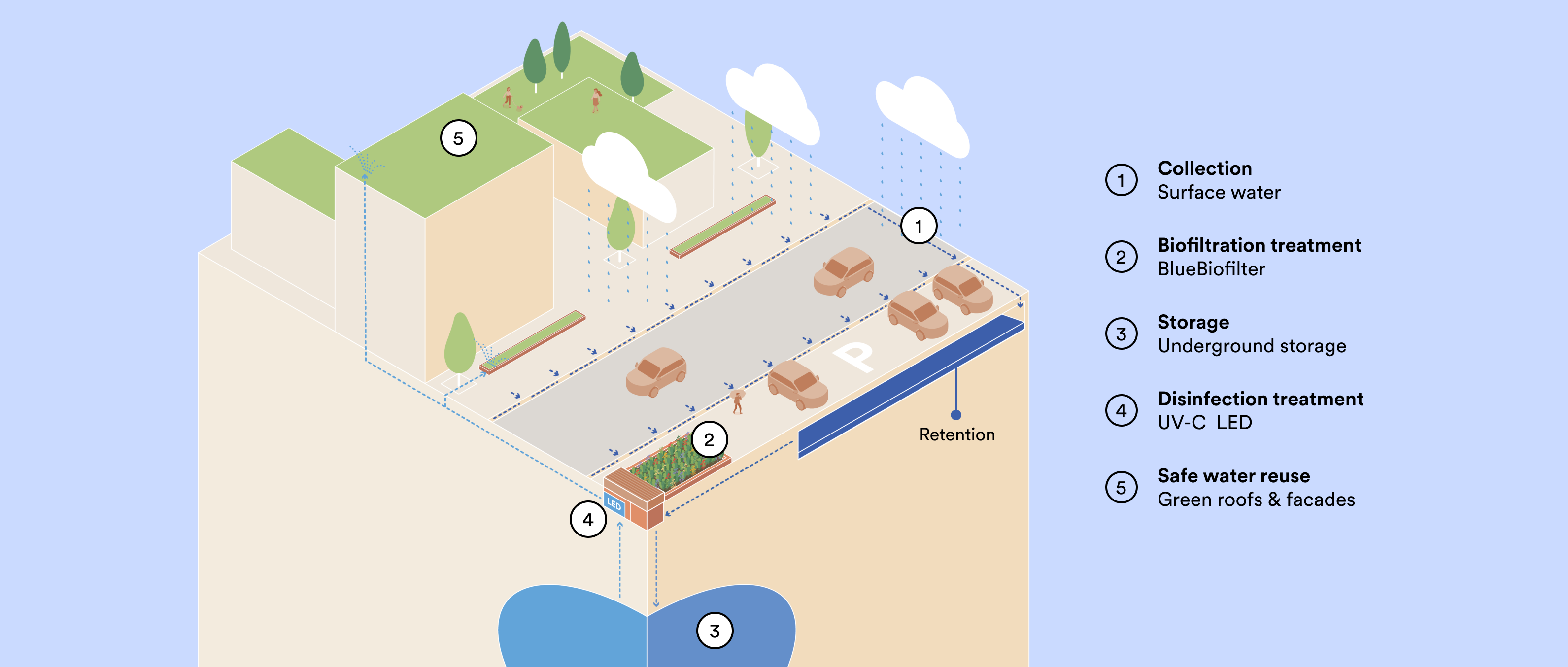Paving the Way for Sustainable Water Solutions in European Cities
GreenLED aims to revolutionise urban water management, harnessing locally sourced rainwater as a sustainable resource.
As Europe grapples with the adverse effects of drought, population growth, and increasing water demand, the innovative LIFE GreenLED project emerges as a beacon of hope for urban areas facing water shortages. In response to these challenges, GreenLED will offer a unique solution, allowing urban facilities to harness locally collected rainwater instead of relying solely on potable water.
Necessary changes to adopt
We face a current reality: European cities are increasingly feeling the strain of drought resulting in pressure on urban water supplies. Despite this, potable water, a precious resource, continues to be utilised for activities that do not require such high-quality water, reducing the availability of water for human consumption and at times even leading to restrictions on its use. In this context, it is clear that the use of drinking water for non-potable purposes is no longer sustainable, and there is an urgent need for alternative solutions. Recognising the need to reduce dependency on potable water, GreenLED advocates for adopting alternative water sources. By doing so, cities can adapt to climate change and safeguard their limited water supply, addressing the consequences of drought and the growing demand for water in urban areas.
Why GreenLED?
Monitored by the Technical University of Delft and the Polytechnic University of Madrid, GreenLED seeks to demonstrate the effectiveness of rainwater as an alternative water source while complying with health and water quality regulations. More precisely, the project introduces a comprehensive system combining collection, biological treatment, and aquifer storage of rainwater, with UV-C LED disinfection prior to reuse. This chemical-free, natural, and environmentally friendly approach removes pollutants, offering a circular water management solution. The resulting high-quality water is suitable for close-contact urban applications, contributing to climate adaptation and water neutrality.
GreenLED utilises an all-in-one storage, supply and disinfection system. It combines the water supply system BlueBloqs by FieldFactors, a nature-based biofiltration and aquifer storage technology, with a post-treatment using UV-C LED disinfection by APRIA, a mercury free and highly effective technology ensuring the water meets safety requirements for applications with high risk of human contact , such as the irrigation of urban areas, green roofs, green facades, or supply of urban ponds and fountains.
Four years, two real-world tests
Over four years, GreenLED will develop and test this innovation in two demonstration sites: Alphen aan den Rijn (the Netherlands) and Madrid (Spain).
In Alphen aan den Rijn, the initiative aims to make the city centre greener by disconnecting the discharge of 31,000 m2 of roof surface from the sewer system, and instead supplying 15 million litres of rainwater annually to mitigate the urban heat island effect and enhance environmental resilience.
In Madrid, the solution will be implemented in Los Ahijones urban development to fill a city park pond with purified rainwater. The aim is to provide a year-round water supply for high-quality applications, enhancing water sustainability in the region.
The 4-year demonstrative EU-funded LIFE project, initiated in July 2023, is set to present its final results in June 2027 with the aim to inspire other cities to adopt similar sustainable water management practices.
Behind the project
The GreenLED project is funded by the EU funding instrument for the environment and climate action, LIFE. It is implemented by a Dutch-Spanish consortium composed of six partners: The municipality of Alphen aan den Rijn, APRIA Systems, FieldFactors, Junta de Compensación los Ahijones, Delft University of Technology, and Universidad Politécnica de Madrid.






Why GreenLED?
Monitored by the Technical University of Delft and the Polytechnic University of Madrid, GreenLED seeks to demonstrate the effectiveness of rainwater as an alternative water source while complying with health and water quality regulations. More precisely, the project introduces a comprehensive system combining collection, biological treatment, and aquifer storage of rainwater, with UV-C LED disinfection prior to reuse. This chemical-free, natural, and environmentally friendly approach removes pollutants, offering a circular water management solution. The resulting high-quality water is suitable for close-contact urban applications, contributing to climate adaptation and water neutrality.
GreenLED utilises an all-in-one storage, supply and disinfection system. It combines the water supply system BlueBloqs by FieldFactors, a nature-based biofiltration and aquifer storage technology, with a post-treatment using UV-C LED disinfection by APRIA, a mercury free and highly effective technology ensuring the water meets safety requirements for applications with high risk of human contact , such as the irrigation of urban areas, green roofs, green facades, or supply of urban ponds and fountains.
TU Delft's role in GreenLED
TU Delft takes centre stage in the GreenLED project, wielding its water management and technology expertise. Tasked with a pivotal role in designing the BlueBloqs-LED system, TU Delft conducts thorough cost and impact evaluations, ensuring an integrated approach. Beyond design, the university assesses working pilots, influencing continuous improvements. Focusing on planning the exploitation of BlueBloqs-LED, TU Delft evaluates key performance indicators, ensuring project effectiveness.
The Department of Water Management at TU Delft brings valuable knowledge in water treatment processes, nature-based solutions for urban drainage, and water quality monitoring in sandy media. This expertise aligns seamlessly with the project's goals. Two EngD students have been enlisted to execute primary tasks, emphasizing TU Delft's commitment.
The organization's contribution extends across critical milestones, encompassing the integrated system design of the BlueBloqs-LED, technical viability assessments and optimization, impact evaluations, active participation in sustainability and replication strategies, and exploitation of project results. This commitment underscores TU Delft's dedication to the project's success, culminating in milestones like the closing conference and the graduation of two EngD students.

